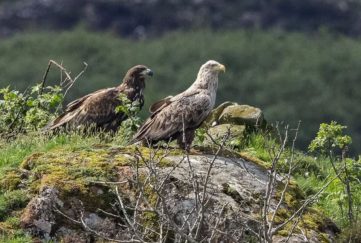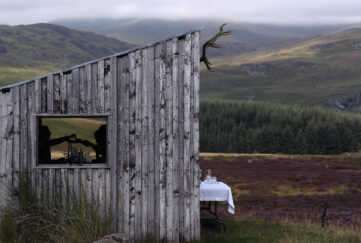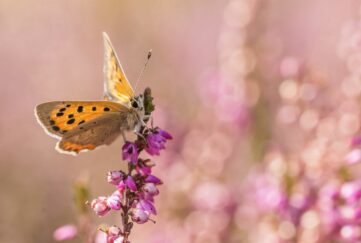Sense Of Belonging – Jim Crumley
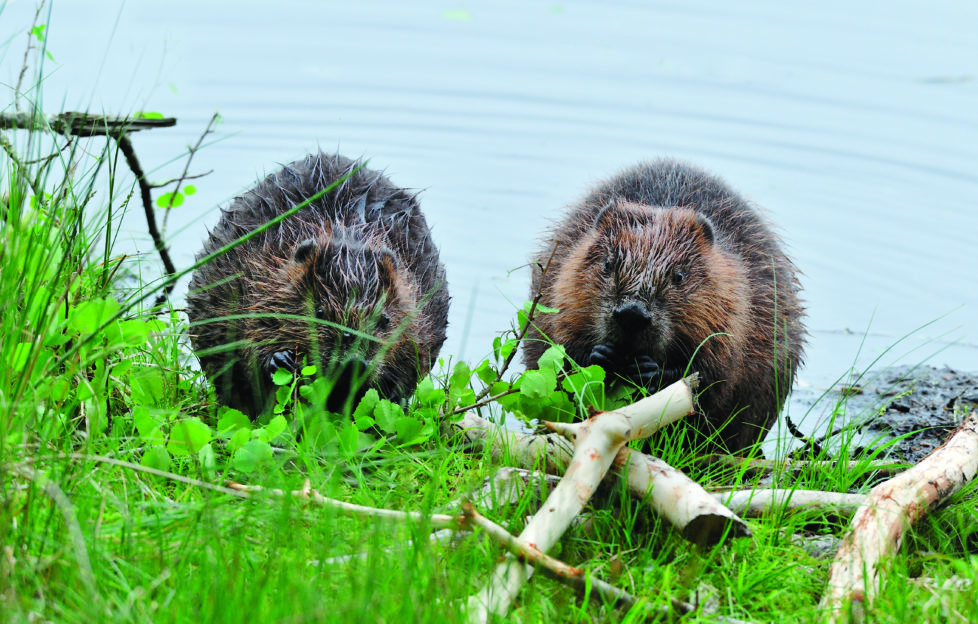

As Scotland finally welcomes the legal protection of the Eurasian beaver, we take a look back at Jim Crumley’s piece on the far-reaching benefits of safe-guarding this beautiful creature
The American naturalist Ernest Thompson Seton wrote, 105 years ago: “…the beaver is the animal that most manifests intelligence by its works, forestalls man in much of his best construction, and amazes us by the well-considered labour of its hands.
“There was a time when the beaver’s works and wisdom were so new and astounding that super-human intelligence was ascribed to this fur-clad engineer. Then the scoffers came and reduced him to the low level of his near kin, and explained the accounts of his works as mere fairy tales. Now we have got back to the middle of the road. We find him a creature of intelligence far above
that of his near kinsmen, and endowed with some extraordinary instincts that guide him in making dams, houses, etc, that are unparalleled in the animal world…”
The chances are, you’ve never spotted one
So here we are again; the scoffers are out in force, and the journey back to the middle of the road has begun. It is a longer journey in today’s Scotland than it ever was in North America. Our beavers have been gone completely for the better part of 400 years. Unlike the Americans, we have no social memory of living with beavers, no inherited sense of their ecological value.
The chances are you have never seen a beaver, given its dusk-till-dawn night shift predilection. At its chunkiest, its nose-to-tail length is a yard-and-a-half, and it possesses the kind of power-to-weight ratio that can fell, say, a 40ft tall tree with a trunk 15 inches in diameter, and having felled it, lopped its branches, stored or eaten its foliage, and manipulated the trunk improbable distances through still or turbulent water to its final destination.
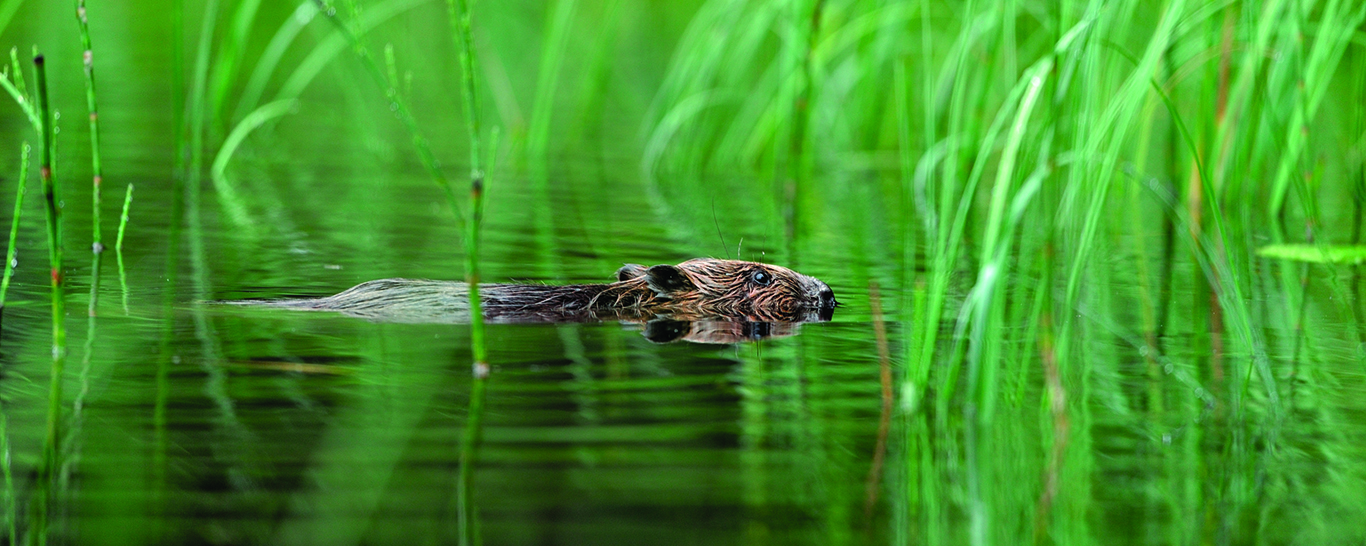
A creature of uncanny wisdom. Pic credit: Laurie Campbell.
Or it may just leave the trunk where it lies and return for it later. Or it may forget about it. Not every tree the beaver fells is necessary for architecture. Sometimes the beaver is just servicing its tools, specifically its incisors. These simply never stop growing, so must be worn down at the same rate at which they grow. The beaver does that by biting wood, more wood than it can possibly use.
Every beaver landscape has…
So every beaver landscape has its felled but discarded trees, often lying half out of the water as though indecision about its fate had so tormented the feller that the problem of what to do next had proved insurmountable.
Every beaver landscape has its standing trees eaten part of the way through the trunk and then abandoned. Confronted with such a landscape, some human observers wail about vandalism, loss of native trees for no good reason; they harden their hearts against what they see as this most unwelcome of intruders. And so they shoot them.
The trouble with that interpretation of events is that it is based on 400 years of human history in a landscape devoid of beavers. All our understanding of the way river systems work is based on river systems without beavers.
Yet river systems with beavers are nature’s preferred option across the entire northern hemisphere. So today, any landscape in Britain that has recently acquired beavers has some catching up to do.
Even after 400 years, landscapes once suitable for beavers don’t stop being suitable.
Many of the Scottish landscapes beavers have been able to choose for themselves in the last few years are historic beaver landscapes too. Even after 400 years, landscapes once suitable for beavers don’t stop being suitable. Beavers take a longer view of things. Every beaver generation contributes to a cycle that goes on repeating down the decades, down the centuries, a slow rhythm almost imperceptible to human sensibilities, a rhythm that permits constant renewal of the beaver’s world.
This is how it works.
Beavers like to surround themselves with fast-growing trees like willow, birch, alder and aspen whenever possible, but eventually they eradicate their own supply of food and building materials, and then they move on. If you were to chance on that landscape the day after they had departed you might feel justified in declaiming what you see as desecration, but beavers know what they are doing, and you have not seen what comes next.
Beaver dams and lodges collapse, slowly.

The pools and ponds that the beavers create, spread and evolve. Pic credit: Laurie Campbell.
Over years and decades, the canals and pools and ponds the beavers created, spread and evolve into that most precarious and precious state of landscape we call wetland. By then, many of the tree stumps have begun to regenerate into low scrub.
Surrounding woodland begins to advance, new generations of the very water’s-edge tree species the beavers had targeted. And in time, in time, the beavers will return, because the land-and-waterscape has prospered in their absence to become suitable for beaver habitation once again, and this time there will be more open water for the beavers to work with. This is the benevolent rhythm to which beaver life moves, a constant cycle of expansion and renewal, and with each stage the beavers create new opportunities for plants, insects, birds, fish and other aquatic life, and water-loving mammals.
The human view of nature’s scheme of things is unwilling to allow the kind of time that beavers need – or that any reintroduced creatures need. Land managers want immediate results, the maximum amount of money in the minimum amount of time. Whenever and wherever nature thwarts modern land use ambition, landowners look for scapegoats to control or cull or render extinct. It’s what their fathers did, and their fathers’ fathers and so on. Those lost generations that did know about co-existence with the other creatures of the earth – often holding some as sacred, some as teachers, some as both – are far beyond the reach of 21st century sensibilities.
The phenomenon is nowhere more evident than in the angling lobby, which has characterised beavers as a disaster-in-waiting for the lucrative salmon fishing industry. And it’s no more willing than the landowning lobby to wait and watch and learn from what happens for a decade or two to see how their fears measure up to the reality
British Columbian eco-engineers
A place where they know a thing or two about wild beavers and wild salmon, and the subtleties of how they co-exist, is British Columbia. A four-page spread in British Columbia Magazine entitled Leave It To Beavers listed “10 reasons to praise B.C.’s eco-engineers”. Number six was “They protect salmon fry”. The article went on: “Fisheries managers used to destroy beaver dams because they thought they interfered with salmon migration.
Now they’re learning that beavers actually improve life for salmon and other fish. Beaver ponds provide excellent rearing habitat for juvenile salmon, with ample food and good cover to protect from predators.
“Beaver dams generally don’t restrict fish movement. Adult salmon can leap most dams, while smaller fish just wriggle through, because a beaver dam is not like a human dam. It’s porous.”

Salmon eggs in a beaver pool. Credit: Laurie Campbell.
Glen Orchy in Argyll is one of my favourite places to watch salmon on the move. The River Orchy’s waterfalls are long and shallow. Salmon have no trouble with the height of the obstacles, but their first leap inevitably lands amid the chaotic tumbledown of huge rocks, mini-falls within falls, chutes and pools and whirlpools, and the press of the river. There are difficult ways up the falls for the strongest fish, and wriggle-routes for the small fry.
I never thought about it as having the properties of a beaver dam. Now I am conversant with a range of beaver dams, canals and pools, I see only benefits for salmon.
In a new landscape, or rather a very old landscape they have reclaimed, beavers begin to reshape what they find.
The beaver achieves transformation by its capacity to generate wetland then expand it, and to clean up the rivers it colonises – its architecture acts as a series of underwater sumps to which bacteria cling and are slowly broken down, a phenomenon already measurable in Scotland.
Number seven in the British Columbia Magazine’s 10 reasons was, “They purify streams”.
“Wetlands have been called the ‘kidneys of the landscape’ because they work to purify the water that passes through them. Beavers help keep these vital organs functioning.
“When a beaver pond slows the flow of a stream, sediments and pollutants settle out, cleansing the water before it continues downstream. Meanwhile, pond plants and micro-organisms break down potentially harmful substances that are left behind.”
Like the wolf…
The beaver – like the wolf – is an innovator for nature. One of the species to benefit immediately from the wolf’s reintroduction to Yellowstone was the beaver. Once regeneration of the fastest growing trees got going in the wake of the wolves’ impact on elk herds, the beavers from just outside Yellowstone noticed the change. They followed the wolves, scattering wetland as readily as the wolves scattered the deer herds. Following the beavers came water-loving plants, insects, birds and a myriad life- forms including frogs, otters, turtles and moose. What we will see, if we give our beavers time, is just such a miracle.
The beaver is prospering all over Europe. There have been reintroductions in 25 countries. Given the pool of knowledge that exists in the wake of such widespread conservation measures, it makes Scotland’s official five-year trial in Argyll with a handful of beavers look timid, and the hostility on Tayside look petulant.
Yet had it not been for the unofficial reintroduction into the Tay catchment, and the beavers’ determined explorations that now range as far as Rannoch and into the Forth catchment in the Trossachs, the official trial might have produced no lasting results at all. As it is, the un-tagged, un-chipped, free-range, exploratory Tayside population is now so well-established and thriving that surely the point of no return is far behind us.
You can read more of Jim Crumley’s Scottish wildlife columns online here, and each month in The Scots Magazine.


